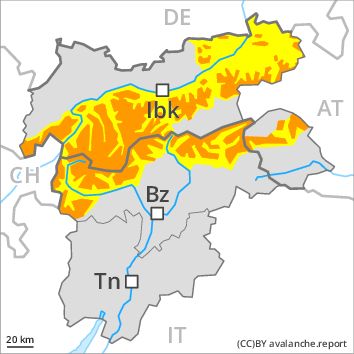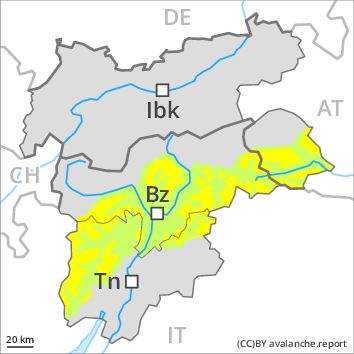Regions
Karwendel Mountains, Western Lechtal Alps, Central Lechtal Alps, Western Verwall Mountains, Eastern Verwall Mountains, Northern Zillertal Alps, Allgäu Alps, Venediger Range, Eastern Lechtal Alps - Ammergau Alps, Mieming Mountains

Danger level
Danger Level 4 - High above 1600m
Danger Level 3 - Considerable above 1600m
Avalanche Problem
Wind-drifted snow above 1600m, N-NE-E-SE-S-SW-W-NW

The backcountry and freeriding conditions are very critical. Fresh and older wind slabs represent the main danger.
As a consequence of fresh snow and a storm force to violent wind, extensive wind slabs formed in the last two days especially in gullies and bowls and behind abrupt changes in the terrain. Even single winter sport participants can release avalanches in many places, including dangerously large ones. The brittle wind slabs are covered with fresh snow and therefore difficult to recognise. They will increase with altitude. As a consequence of warming during the day, the likelihood of dry slab avalanches being released will increase further.
As a consequence of solar radiation individual natural loose snow slides are possible. This applies in particular on extremely steep sunny slopes.
Snowpack
dp 6: cold, loose snow and wind
dp 9: graupel blanketed with snow
Since Tuesday extensive wind slabs formed above approximately 1600 m. The various wind slabs have bonded poorly together. The old snowpack will be wet all the way through below approximately 2300 m.
Tendency
The backcountry and freeriding conditions remain critical.
Regions
Val Müstair Alps, Langtaufers, Schnals Ridge, Silvretta, Southern Stubai Alps, Samnaun Mountains, Southern Zillertal Alps and High Tauern, Northern Oetz and Stubai Alps, Saldurn-Mastaun Ridge, Western Tuxer Alps, Texel Mountains, Eastern Tuxer Alps, Western Kitzbühel Alps, Western Pfunderer Mountains, Eastern Kitzbühel Alps, Glockturm Range, Eastern Pfunderer Mountains, Durreck Range, Weißkugel Range, Western Rieserferner Mountains, Gurgler Range, Central Stubai Alps, Ortler Range, Eastern Rieserferner Mountains, Glockner Range, Brandenberg Alps, Wilder Kaiser Mountains - Waidring Alps, Grieskogel Mountains

Danger level
Danger Level 3 - Considerable above 1600m
Danger Level 2 - Moderate above 1600m
Avalanche Problem
Wind-drifted snow above 1600m, N-NE-E-SE-S-SW-W-NW

The backcountry and freeriding conditions are critical. Fresh and older wind slabs represent the main danger.
As a consequence of fresh snow and a storm force to violent wind, extensive wind slabs formed in the last two days especially in gullies and bowls and behind abrupt changes in the terrain. Especially in places where the wind is storm force the avalanche danger is greater. The brittle wind slabs will be covered with fresh snow in some cases and therefore difficult to recognise. They will increase with altitude. Even single winter sport participants can release avalanches in many places, including dangerously large ones. As a consequence of warming during the day, the likelihood of dry slab avalanches being released will increase.
As a consequence of solar radiation individual natural loose snow slides are possible. This applies in particular on extremely steep sunny slopes.
Snowpack
dp 6: cold, loose snow and wind
dp 9: graupel blanketed with snow
The fresh snow of the last two days has bonded well with the old snowpack. Since Tuesday extensive wind slabs formed in particular above approximately 1600 m. The various wind slabs have bonded poorly together. The old snowpack will be wet all the way through below approximately 2300 m.
Tendency
The backcountry and freeriding conditions remain critical.
Regions
Sexten Dolomites, Latemar, Western Deferegger Alps, Ulten Valley, Eastern Nonsberger Alps, Northern Dolomites of Fiemme, Gröden Dolomites, Southern Adamello, Eastern Deferegger Alps, Prags Dolomites, Sarntal Alps, Adamello - Presanella, Schober Mountains, Northern Brenta - Peller, Lienzer Dolomites, Western Nonsberg Alps, Southern Brenta, Fassa Valley, Sole, Pejo and Rabbi, Maddalene

Danger level
Danger Level 2 - Moderate above 1800m
Danger Level 1 - Low above 1800m
Avalanche Problem
Wind-drifted snow above 1800m, N-NE-E-SE-S-SW-W-NW

Fresh wind slabs.
The mostly shallow wind slabs of the last two days can be released easily. or in isolated cases naturally,. The avalanche prone locations are to be found in particular adjacent to ridgelines and in gullies and bowls in all aspects. They will increase with altitude. In the regions neighbouring those that are subject to danger level 3 (considerable) the avalanche danger is higher.
Snowpack
dp 6: cold, loose snow and wind
In some localities up to 10 cm of snow. fell. This applies in particular in the regions neighbouring those that are subject to danger level 3 (considerable). The sometimes storm force wind has transported the fresh and old snow significantly. In particular adjacent to ridgelines and in gullies and bowls brittle wind slabs formed. This applies in particular above approximately 1800 m.
Tendency
The danger of dry slab avalanches will decrease gradually.



